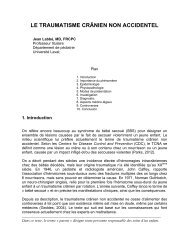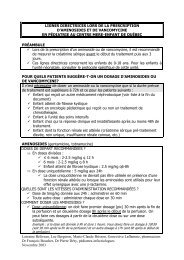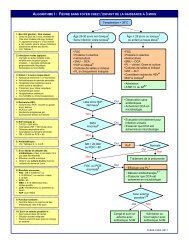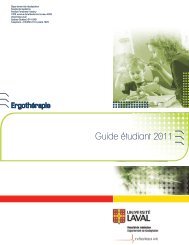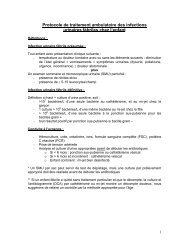L'ergothérapie au-delà du PECPA
L'ergothérapie au-delà du PECPA
L'ergothérapie au-delà du PECPA
You also want an ePaper? Increase the reach of your titles
YUMPU automatically turns print PDFs into web optimized ePapers that Google loves.
L’ergothérapierapie<strong>au</strong>-deldelà <strong>du</strong> <strong>PECPA</strong>Par :Marie-Pierre BélangerBVicky CôtéMarilou Dubé-GirardGabrielle GirouxAnnabelle JulienCatherine Trudel
Intro<strong>du</strong>ctionNotre travailRegrouper des recherchesscientifiques se penchant sur lesdifférentesapproches pouvant in<strong>du</strong>iredes effets bénéfiquessur la personneatteinte de démence.
Intro<strong>du</strong>ctionPlus de 35% des personnes âgéesde85 ans et plus sont atteintes d’uneforme de démenceImpacts sur la cognition, lecomportement et l’habileté àperformer dans les AVQ/AVDFarde<strong>au</strong> pour la famille et sourced’incompréhensionpour lesintervenants
Plan de la présentationRecension des écrits– Approche environnementale– Approche relationnelle– Approche par l’activitlactivitéDiscussionRôles de l’ergothlergothérapeute rapeute etapplications cliniquesConclusion
Approche environnementaleDéfinitionEnvironnement sécuritaire set adaptévisant à compenser les déficits dcognitifs des résidents rsidents (Lalande & Leclerc, 2004)Moins de résidents rque dans une unitétraditionnelle (Reimer et al., 2004)Biodiversité (Reimer et al., 2004)
Approche environnementaleDéfinition (suite)Conçu u pour ressembler <strong>au</strong> domicile(Reimer et al., 2004)Accès s sécuritairesà l’environnementextérieur(Reimeret al., 2004)Possibilité de participer <strong>au</strong>x tâchesdomestiques (Reimer et al., 2004)
Approche environnementaleProjet EQUAL (Torrington, 2003)Grands établissements = sécurité etsoinsMoyens établissements = opportunités s de normalisation etpersonnalisationPetits établissements = confort,normalisation et contrôle
Approche environnementaleEffets positifs fonctionnement dans AVQ(Reimer et al., 2004) intérêt(Reimer et al., 2004) anxiété/peur(Reimer et al., 2004) contrôle et qualité des stimulations(Morgan et al., 2004)
Approche environnementaleEffets positifs (suite) orientation (Morgan et al., 2004) comportements perturbateursverb<strong>au</strong>xverb<strong>au</strong>x (Wilkes et al., 2005, Lalande & Leclerc, 2004) <strong>au</strong>tonomie fonctionnelle(Lalande & Leclerc, 2004)
Et selon le MOH…Impacts sur la volition, l’habituation letles habiletésIntervention <strong>au</strong> nive<strong>au</strong> del’environnement social et physique vuela nature progressive de la maladie3 interventions possibles: adapter lemilieu de vie, adapter les activités,utiliser une approche relationnelle
DéfinitionL’approche relationnelleFaçon d’intervenir d<strong>au</strong>près s d’une dpersonneAméliorer le fonctionnement émotif, socialet la qualité de vieAider le client à faire face <strong>au</strong>xconséquences de la maladieMaintenir un meilleur potentiel fonctionnel
Effets de l’approche lrelationnelle surles patientsRecherches surtout pour les démencesdlégèresà modéréesFavorise un meilleur équilibreémotionnel(FinnemaFinnema & al., 2005, Lai et al., 2003)Préservation d’une dimage de soipositive et <strong>du</strong> sentiment decompétence(Finnemaet al. 2005)
Effets de l’approche lrelationnelle surles patients (suite)Diminution des comportementsperturbateurs (Finnemaet al., 2005, Moniz2003, Greenwood, , 2001)et al., 2005, Moniz-Cook et al.,Responsabiliser le client et l’impliquerldans la relation (Greenwood,, 2001)Formation <strong>du</strong> personnel permetd’<strong>au</strong>gmenter la qualité de vie (Magai(2002)Magai et al.,
Effets de l’approche lrelationnelle surle personnel soignantChez les personnes ayant intégrgrées lemieux l’approche lrelationnelleAmélioration des réactions rde stress(Finnemaet al., 2005, Schrijnemaekers et al., 2003)Amélioration <strong>du</strong> sentiment decompétence et de la satisfactionpersonnelle (Finnemaet al., 2005, Schrijnemaekers etMeilleure qualité des soinset al., 2003)
Et selon le MOH… (suite)Favorise la participationoccupationnelle de la personne et unemeilleure adaptation/interaction avecson environnementLe maintien des rôles et la participationoccupationnelle mènent mà une identitéoccupationnelle positive
Approche par l’activitlactivitéDéfinitionActivités s de loisirsAdaptées <strong>au</strong>x intérêts et/ou <strong>au</strong>xhabiletés s de la personneAdaptéesà l’âge ou <strong>au</strong>x stades derégression cognitive
Approche par l’activitlactivitéEffets sur la personne (suite)Diminution de la passivité (Kolanowski2005, Fitzsimmons et al., 2002)Kolanowski et al.,Diminution de l’agitationl(Kolanowskiet al.,2005, Fitzsimmons et al., 2002)Diminution de l’anxilanxiété dans lesderniers stades (Egan et al., 2006)Aucun effet sur l’agitation l(Beck etBeck et al., 2002)
Approche par l’activitlactivitéFacteurs affectant le temps et le nive<strong>au</strong> departicipationLe support <strong>du</strong> personnel soignant<strong>au</strong>gmente l’engagement ldans les AVD(Funaki et al., 2005)Le statut cognitif et la fonction physiqueinfluencent l’engagementl(Kolanowskiet alal., 2006)Meilleure participation avec les activitésliées <strong>au</strong>x intérêts et <strong>au</strong>x habiletés(Kolanowskiet al., 2005, Mahoney, Schneider et al., 2002)
Et selon le MOH…La démence daffecte toutes les sphèresImportance d’adapter dl’activitlactivité <strong>au</strong>xhabiletés s et intérêts actuels de lapersonne pour favoriser laparticipation occupationnelleL’engagement dans l’activitlactivité permetle maintien de l’identitlidentitéoccupationnelle
Plan de la présentationRecension des écrits– Approche environnementale– Approche relationnelle– Approche par l’activitlactivitéDiscussionRôles de l’ergothlergothérapeute rapeute et applicationscliniquesConclusion
DiscussionComplémentaritmentarité entre les approchesDans les unités s prothétiques, tiques, lepersonnel soignant est formé pourutiliser une approche relationnelleDans les unités s prothétiques, tiques, lesactivités s utilisées sont adaptées <strong>au</strong>xpersonnes
DiscussionComplémentaritmentarité dans les approchesDans les bases de l’approchelrelationnelle, l’activitlactivité est adaptéeselon le nive<strong>au</strong> de fonctionnement etde désorientationdLa mise en place d’une dactivitésignificative et adaptée e demande unenvironnement supportant
DiscussionForces de la littératureBe<strong>au</strong>coup d’éd’études quantitativesUtilisation de devis expériment<strong>au</strong>x etsemi-expexpériment<strong>au</strong>x pour la plupart
DiscussionLimites de la littératureAbsence de définition <strong>du</strong>niverselle pourcertains concepts plus abstraits(qualité de vie, approche relationnelle)Subjectivité des concepts étudiés(qualité de vie)Instruments ne mesurent pasdirectement la qualité de vie
DiscussionLimites de la littératureSujets avec démence dsévère ssontsouvent exclus des étudesManque d’éd’études menées es par desergothérapeutesrapeutes
Rôle de l’ergothlergothérapeuterapeuteÉvaluer et adapter l’environnementlEnseignement <strong>au</strong>près s des <strong>au</strong>tresmembres de l’él’équipe et de la familleFavoriser la participationoccupationnelle et une identitéoccupationnelle positiveAnalyser et adapter les activités s enfonction <strong>du</strong> potentiel et des intérêts <strong>du</strong>client
Applications cliniques :EnvironnementPersonnaliser la chambre avec desobjets familiers et significatifsEncourager l’acclaccès à la lumièrenaturelle et à l’extérieurFavoriser l’orientation ltemporelle avecdes calendriers, horloge, etc.
Applications cliniques :Environnement socialRespect et empathieCroire en son potentiel et en sesexpériences antérieuresContact visuel chaleureux, toucherenveloppant, bonne communicationverbaleFavoriser l’<strong>au</strong>tonomie let la mobilité de lapersonne
Applications cliniques :OccupationEngagement dans une occupationsignificativeAdapter l’activitlactivité en fonction <strong>du</strong>nive<strong>au</strong> de désorientation d<strong>du</strong> clientActivité significative est celle quiapporte <strong>du</strong> bien-être <strong>au</strong> clientPermet de faire vivre un sentiment decompétence
Piste de recherche…La connaissance de la personneatteinte de démence dsévère sparses proches peut-elle elle être utiliséepour mesurer le bien-être chezcette personne?Étude qualitative <strong>au</strong>près s des prochesOutils d’éd’évaluation spécifiques et valides
ConclusionLes approches environnementale,relationnelle et par l’occupation lontdes effets bénéfiques bsur le bien-êtredes personnes atteintes de démencedIntervention combinant les troisapproches simultanément ment est de mise
ConclusionValidité des résultats rcompromise parla subjectivité des concepts étudiésPertinence des devis qualitatifs pourdévelopper de nouve<strong>au</strong>x outils afind’améliorer la validité des recherchesquantitatives
RemerciementsMme Line Robich<strong>au</strong>d
QUESTIONS ???
Références1. Albert S. M. (2004). The special Care Unit as a Quality-ofof-Life Intervention for People withDementia. Journal of American Geriatrics Society, , vol. 52, pp.1214-1215.1215.2. Alzheimer’s s Association. (2005). Dementia Care Practice Recommendations for Assisted LivingResidences ans Nursing Homes. Consulté en ligne sur le sitehttp://www.ahca.orgwww.ahca.org/quality/dementia_care_practice_recommendations_05.pdf, , 15 pp.3. Beck C. K., Vogelpohl T. S. et al. (2002). Effects of Behavioral Interventions on DisruptiveBehavior and Affect in Demented Nursing Home Residents. Nursing Research, vol. 51 (no.4),pp.219-227.227.4. Brodaty H. et al. (2003). ISSUES AND INNOVATIONS IN NURSING PRACTICE. Nursing homestaff attitudes towards residents with dementia : strain and satisfaction with work. Journal ofAdvanced Nursing, vol. 44 (no.6), pp.583-590.590.5. Brooker D. (2004). What is person-centred care in dementia?. Reviews in Clinical Gerontology,vol. 13, pp.215-222.222.6. Davis L.A. (2005). E<strong>du</strong>cating Indivi<strong>du</strong>als With Dementia. Perspectives for RehabilitationtionProfessionals. Topics in Geriatric Rehabilitation, , vol. 21 (no.4), pp.304-314.314.7. Egan M. et al. (2006). Dementia and occupation: A review of the literature. The CanadianJournal of Occupational Therapy, , vol. 73 (no.3), pp.132-139.139.8. Finnema E. et al. (2005). The effect of integrated emotion-oriented oriented care versus usual care onelderly persons with dementia in the nursing home and on nursing assistants : a randomized clinicaltrial. International Journal of Geriatric Psychiatry, vol. 20, pp.330-343.343.9. Finnema E. et al. (2000). The effects of emotion-oriented oriented approaches in the care for personssuffering form dementia : a review of the littératurerature. International Journal of Geriatric Psychiatry,vol. 15, pp.141-16116110. Fitzsimmons S., Buettner L. L. (2002). Therapeutic recreation interventions for need-drivendrivendementia-compromisedbehaviors in community-dwelling elders. American Journal of Alzheimer’sDisease and Other Dementias, , vol. 17 (no.6), pp.367-380.380.
Références (suite)11. Funaki Y. et al. (2005). Study on factors associated with changes in quality of life of demented delderly persons in group homes. Scandinavian Journal of Occupational Therapy, , vol. 12, pp.4-9.12. Greenwood D. et al. (2001). A relational approach to providing care for a person sufferingfrom dementia. Journal of Advanced Nursing, vol. 36 (no.4). pp.583-590.590.13. Kolanowski A. et al. (2006). Factors that relate to activity engagement in nursing homeresidents. American Journal of Alzheimer’s s Disease and Other Dementias, vol. 21 (no.1), pp.15-21.14. Kolanowski A. M., Litaker M., Buettner L. (2005). Efficacy of Theory-Based Activities forBehavioral Symptoms of Dementia. Nursing Research, , vol. 54 (no.4), pp.219-228.228.15. Lai C. K. Y. et al. (2004). A randomized controlled trial of a spécificreminiscence approach topromote the well-being of nursing home residents with dementia. International Psychogeriatrics,vol. 16 (no.1), pp.33-49.16. Lalande G., Leclerc G. (2006) Une étude descriptive et comparative de deux modèles québécoisd’hébergement et d’accompagnement dde personnes atteintes de la maladie d’Alzheimer.dconsultéen ligne sur le site <strong>du</strong> Centre de recherche sur le vieillissement t de l’Institut lUniversitaire de gériatrie gde Sherbrooke http://www.iugs.cawww.iugs.ca/FR/400/ /FR/400/nouvelleDetail.asp?Id=67, 5pp.17. Magai C. et al. (2002). Impact of Training Dementia Caregivers in Sensitivity to NonverbalEmontion Signals. International Psychogeriatrics, , vol. 14 (no.1), pp.25-38.18. Malhoney A. E. J. (2003). Age-or stage-appropriate? appropriate? Recreation and the relevance of Piaget’stheory in dementia care. American Journal of Alzheimer’s s Disease and Other Dementias, vol. 18(no.1), pp.24-30.19. Miller P.A., Butin D. (2000). The role of occupational therapy in dementia – C.O.P.E.(Caregiver Options For Practical Experiences). International Journal of Geriatric Psychiatry, vol. 15,pp.86-89.89.
Références (suite)20. Morgan D. G. et al. (2004). Evaluating rural nursing home environments : dementia specialcare units versus integrated facilities. Aging and Mental Health, vol. 8 (no.3), pp.256-265.265.21. Reimer M. A. et al. (2004). Special Care Facility Compared with Traditional Environments forDementia Care : A logitudinal Study of Quality of life. Journal of American Geriatrics Society, , vol.52, pp.1085-1092109222. Powell J. A. (2000). Communication interventions in dementia. Reviews in ClinicalGerontology, , vol. 10, pp.161-168.168.23. Schneider N. M., Camp C. J. (2002). Use of Montessori-Based Activities by Visitors of NursingHome Residents with Dementia. Clinical Gerontologist, vol. 26 (1/2), pp.71-83.24. Schreiner A. S. et al. (2005). Positive affect among nursing home residents with Alzheimer’sdementia: The effect of recreational activity. Aging and Mental Health, vol. 9 (no.2), pp.129-134.134.25. Schrijnemaekers V. J. J. et al. (2003). Effects of emontions-oriented oriented care on work-relatedrelatedoutcomes of professional caregivers in homes for elderly persons. The Journals of Gerontology :Series B : Psychological sciences and social sciences, vol. 58B (issue 1), pg. S50.26. Schrijnemaekers V. et al. (2002). Effects of emotion-oriented oriented care on elderly people withcognitive impairment and behavioral problems. International Journal of Geriatric Psychiatry, vol.17, pp.926-937.937.27. Torrington J. (2006). What has architecture got to do with dementia care? Explorations of therelationship between quality of life and building design in two EQUAL projects. Quality in Ageing-Policy, practice and research, vol. 7 (issue 1), pp.34-48.48.28. Vildström S. et al. (2005). Caregivers’SelfSelf-Initiated Support Toward Their Partners WithDementia When Performing an Everyday Occupation Together at Home. OTJR : Occupation,Participation and Health, , vol. 25 (no.34), pp.149-157.157.29. Wilkes L. et al. (2005). Research. Environmental approach to re<strong>du</strong>cing agitation in olderpersons with dementia in a nursing home. Australasian Journal l on Ageing, vol. 24 (no.3), pp.141-145.





